Transform your outdoor celebrations into unforgettable experiences with stunning garden-themed cakes that’ll leave your guests absolutely mesmerized. Whether you’re hosting a spring birthday party, summer wedding, or garden party, we’ve discovered the most enchanting ways to bring nature’s beauty directly to your dessert table.
Garden cakes aren’t just desserts – they’re edible masterpieces that capture the magic of blooming flowers, lush greenery, and whimsical outdoor charm. From delicate buttercream roses cascading down tiered creations to rustic naked cakes adorned with fresh herbs and edible flowers, these designs offer endless possibilities for every skill level and occasion.
We’ll guide you through creative concepts that range from beginner-friendly techniques to show-stopping centerpieces that’ll have everyone asking for your secret. Get ready to discover how simple ingredients and clever decorating tricks can transform ordinary cakes into garden-inspired works of art that taste as incredible as they look.
Floral Fantasy Cakes That Bloom With Beauty
Floral fantasy cakes transform any garden celebration into a botanical wonderland that rivals Mother Nature herself. We’re diving into three stunning approaches that’ll make your guests question whether they’re admiring real flowers or edible masterpieces.
Buttercream Flower Garden Designs
Buttercream flowers offer endless possibilities for creating realistic garden blooms that taste as amazing as they look. We start with classic roses using star tips 18 and 21, building layers from the center outward to achieve natural petal curves. Peonies emerge beautifully with tip 104, creating ruffled layers that mimic the flower’s signature fullness.
Sunflowers bring sunny warmth to any cake when piped with yellow buttercream and tip 352 for realistic petals. We recommend creating a textured center using chocolate crumbs or crushed cookies to replicate the flower’s natural seed pattern. Lavender sprigs add elegant height using tip 233, while delicate baby’s breath appears magical when dotted with small round tips.
Color gradients elevate these designs from amateur to professional level in minutes. We blend different shades within the same piping bag, creating natural color variations that real flowers display. Purple to white ombré creates stunning wisteria cascades, while pink to coral transitions make roses appear freshly picked from the garden.
Fondant Rose and Peony Creations
Fondant roses require patience but deliver show stopping results that photograph beautifully for special occasions. We roll thin petals individually, starting with a small cone base and gradually adding layers while varying petal sizes. Each petal gets attached slightly overlapping the previous one, creating natural depth and shadow.
Peonies demand a different technique using multiple thin layers of ruffled fondant petals. We create these ruffles by rolling the edges with a ball tool, then gathering them slightly before attachment. The key lies in building from the inside out, with smaller ruffled pieces at the center expanding to larger outer petals.
Realistic coloring transforms white fondant into garden fresh blooms using gel food coloring and dusting powders. We apply colors in thin layers, building intensity gradually rather than applying heavy color all at once. Burgundy roses benefit from deep red bases with darker edges, while coral peonies shine with yellow centers fading to pink tips.
Edible Fresh Flower Arrangements
Edible fresh flowers bring authentic garden beauty directly onto your cake without any artificial elements. We source pesticide free varieties like violas, pansies, nasturtiums, and rose petals from specialty grocery stores or grow them ourselves. These flowers provide natural colors and delicate flavors that complement cake flavors perfectly.
Preparation involves gentle washing and thorough drying before placement on the cake surface. We remove stems and any green parts that might taste bitter, keeping only the colorful petals or small whole flowers. Sugar coating preserves flowers longer by lightly brushing them with egg white and dusting with superfine sugar.
Placement strategy creates the most impact when flowers cascade down one side or cluster at the base. We avoid overwhelming the design by choosing 2-3 flower varieties maximum, allowing each type to shine individually. Lavender buds pair beautifully with lemon cakes, while rose petals complement vanilla or strawberry flavors naturally.
Storage requires immediate refrigeration after decorating to maintain flower freshness and prevent wilting. We add flowers just before serving when possible, or store decorated cakes in cool environments for maximum 4-6 hours. Remove flowers before cutting and serving to guests who might have flower allergies.
Vegetable Garden Themed Cake Masterpieces

Creating vegetable garden themed cakes transforms ordinary desserts into edible landscapes that celebrate nature’s bounty. These masterpieces capture the essence of thriving gardens through clever design elements and realistic fondant work.
Carrot Patch Cake Designs
Carrot patch cakes showcase rows of fondant carrots protruding from rich chocolate “soil” to create stunning visual impact. We love how these designs mimic actual garden beds with their organized carrot arrangements. Orange fondant carrots peek through dark chocolate crumb layers, while green fondant tops add authentic detail. Adding complementary vegetables like lettuce heads and cherry tomatoes enhances the garden theme dramatically. Decorators often place small garden tools or miniature fencing around the cake’s perimeter for extra charm.
Herb Garden Miniature Landscapes
Tiered herb garden cakes represent different herbs across multiple levels, creating dimensional garden landscapes. Each tier showcases exact herbs like basil, rosemary, or mint through realistic fondant work and fresh garnishes. Fresh herb sprigs placed strategically around each tier provide authentic aromas and visual appeal. Small plant labels crafted from edible paper add professional touches that guests absolutely adore. We recommend using buttercream in various green shades to create depth between different herb sections.
Farmers Market Vegetable Displays
Farmers market cake displays arrange colorful fondant vegetables to replicate bustling market stands perfectly. Sugar crafted vegetables including pumpkins, cauliflower, and broccoli create vibrant arrangements around cake bases. Positioning these edible vegetables in wooden crates or baskets adds authentic market atmosphere. Color variety becomes crucial here, with orange pumpkins, purple eggplants, and red tomatoes creating eye catching displays. We suggest incorporating small chalkboard signs with vegetable names to complete the farmers market experience.
Butterfly and Bee Garden Cake Inspirations
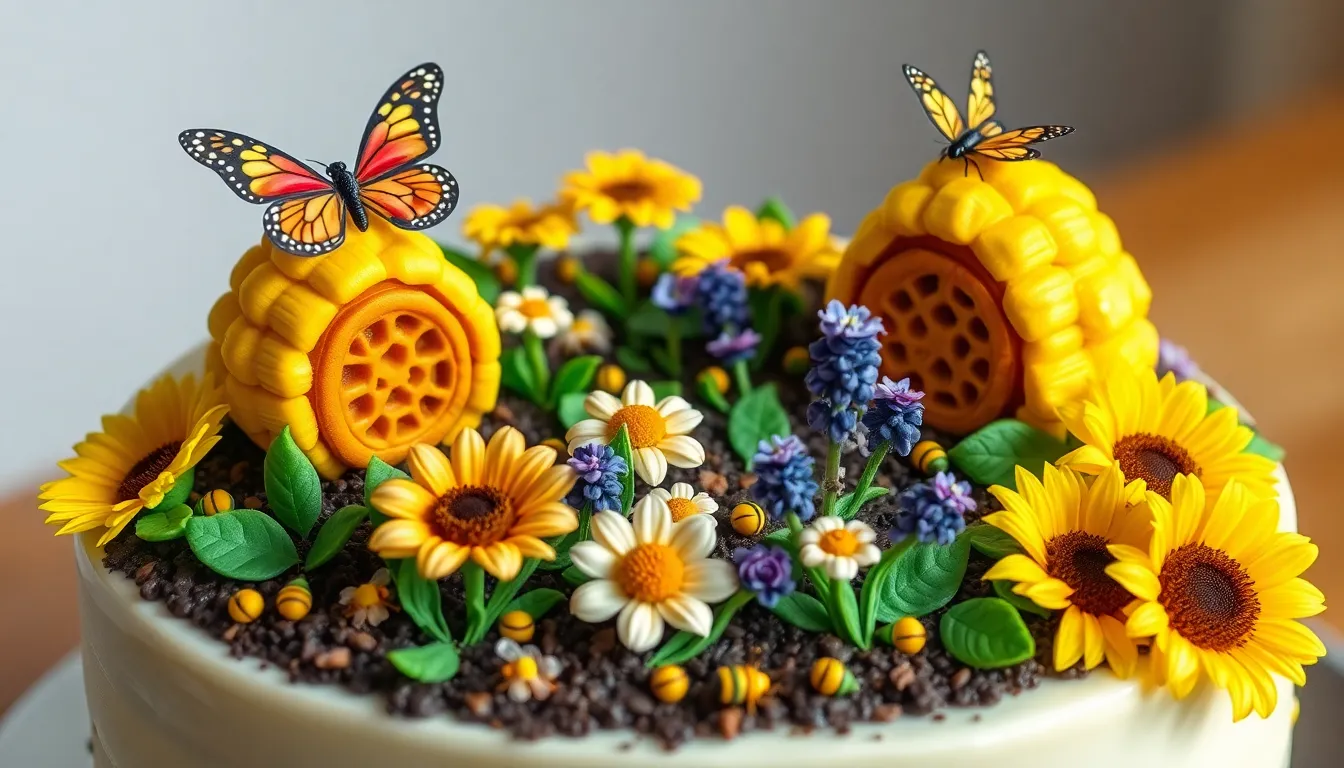
These delicate pollinator designs transform ordinary cakes into enchanting garden scenes that celebrate nature’s most beloved visitors. We’ll explore techniques that bring butterflies and bees to life with stunning detail and realistic textures.
3D Butterfly Cake Toppers
Creating lifelike butterfly toppers requires careful attention to detail and proper structural support. We recommend using fondant or sugar paste to create intricate wing patterns that mimic real butterfly species like monarchs, swallowtails, and painted ladies.
Wire armatures provide essential support for achieving natural poses and positions. Professional decorators insert thin floral wire through the butterfly bodies to create graceful wing angles and realistic flight positions. This technique allows the butterflies to appear as if they’re landing delicately on flower petals or hovering above the cake surface.
Edible dust and petal dust add stunning color gradients to butterfly wings. We suggest layering multiple shades to create depth, starting with lighter base colors and building up to darker edge details. Food coloring markers work perfectly for adding intricate vein patterns and wing markings that make each butterfly unique.
Honeycomb and Beehive Decorations
Beehive cakes showcase the architectural beauty of these natural structures while celebrating hardworking pollinators. Round cake layers stacked in graduated sizes create the classic dome shape, while golden fondant provides the perfect base for texture work.
Honeycomb patterns emerge using specialized textured mats or careful spatula work on buttercream surfaces. We achieve the most realistic results by pressing hexagonal bubble wrap into soft fondant, creating uniform six-sided cells that mirror actual honeycomb construction. Golden glaze applied over these patterns mimics the appearance of fresh honey dripping from the comb.
Small fondant or chocolate bee figures add movement and life to beehive designs. Position these tiny pollinators around the hive entrance, on nearby sugar flowers, or appearing to fly between different cake elements for maximum visual impact.
Pollinator Garden Scene Designs
Comprehensive garden scenes combine multiple pollinator elements into cohesive industry designs. Sugar flowers arranged in natural clusters create realistic garden beds where fondant insects can interact with their environment.
Flower arrangements should include pollinator favorites like sunflowers, lavender, and wildflower varieties made from buttercream or fondant. We recommend varying flower heights and grouping similar species together, just as they’d grow in actual garden settings. This approach creates visual interest while maintaining botanical accuracy.
Garden elements like tiny fondant stones, realistic leaves, and miniature branches enhance the natural setting. Small chocolate “soil” areas between flower groupings provide resting spots for bee and butterfly figures. Edible moss made from colored coconut adds texture and helps blend different cake sections seamlessly together.
Multiple pollinator species working throughout the scene create ever-changing storytelling. Include various butterfly species, different bee types, and even small fondant ladybugs or dragonflies to represent the diversity found in thriving garden ecosystems.
Fairy Garden Cake Ideas for Whimsical Celebrations
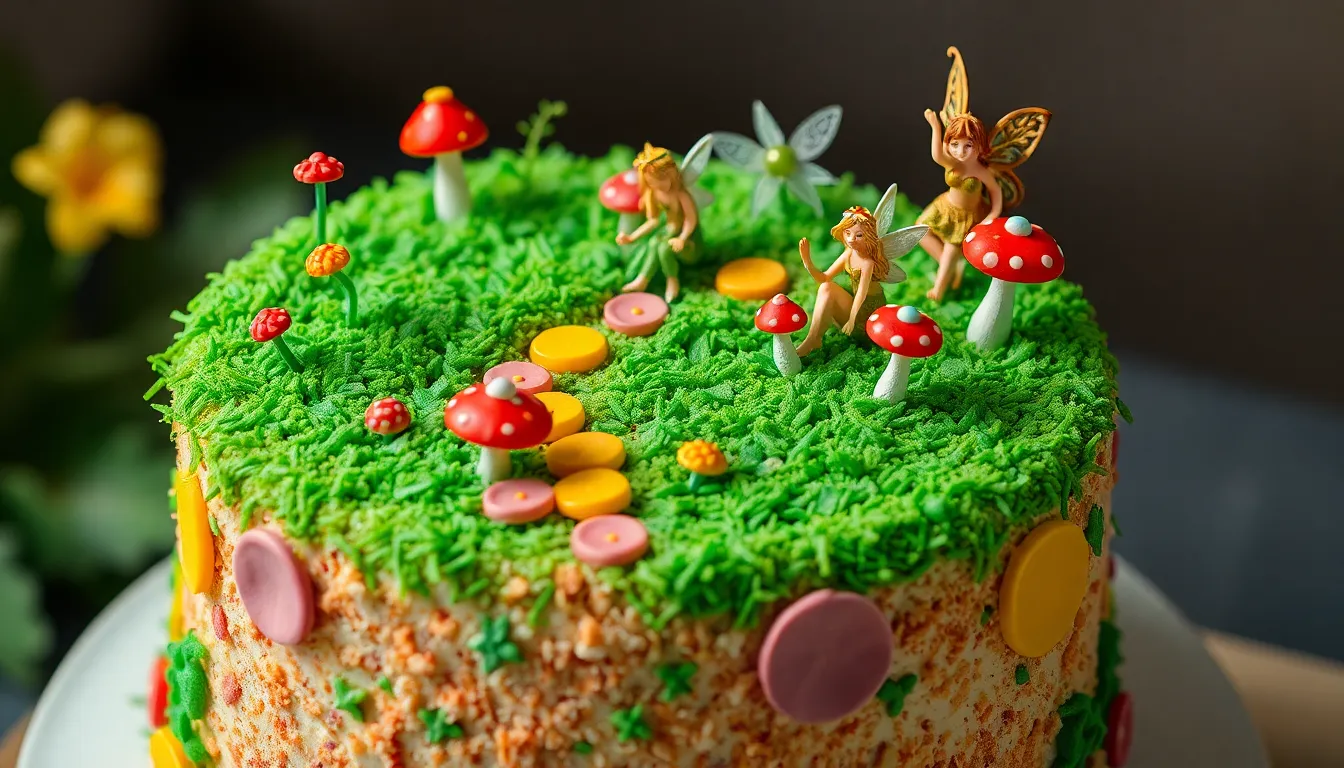
Fairy garden cakes transport guests into enchanted worlds where magic comes alive through edible artistry. These whimsical creations feature intricate details that spark imagination and wonder at every celebration.
Miniature Garden Fairy Figurines
Creating delicate fairy figurines from gum paste or fondant forms the heart of any magical garden cake design. We create these miniature characters with careful attention to detail, painting their wings with iridescent food coloring and adding flowing hair made from pulled sugar work. Positioning them strategically among flowers and toadstools brings the entire cake scene to life.
Garden fairy figurines can wear different outfits to match seasonal themes or party colors. We often create multiple fairies for larger cakes, giving each one unique poses and expressions to tell a story. Small details like tiny flower crowns, wands, or even miniature pets enhance their charm and make each figurine special.
Mushroom and Toadstool Decorations
Spotted toadstools made from fondant or gum paste add playful whimsy to fairy garden cake designs. We shape the mushroom caps by molding fondant over small bowls to achieve the perfect dome shape, then paint them with vibrant reds, oranges, and yellows. White spots created with small fondant circles or piped royal icing complete the classic fairy tale look.
Various sizes of mushrooms create depth and visual interest across the cake surface. We cluster smaller toadstools around fairy houses while using larger ones as focal points throughout the garden scene. Different mushroom varieties like button mushrooms and bracket fungi expand the natural garden atmosphere.
Secret Garden Pathway Designs
Winding pathways created from crushed cookie crumbs or colored sugar lead guests through the magical cake industry. We press these edible materials into curved patterns that snake around fairy houses and between flower clusters, creating the illusion of well worn garden trails. Small candy rocks and flower sprinkles scattered along the edges enhance the pathway’s natural appearance.
Stepping stone pathways offer another enchanting design option using round fondant pieces painted to look like weathered garden stones. We space these evenly to create a realistic walking path that guides the eye around the entire cake design. Moss effects achieved with green coconut flakes or piped buttercream add authentic garden touches to pathway borders.
Seasonal Garden Cake Themes Throughout the Year
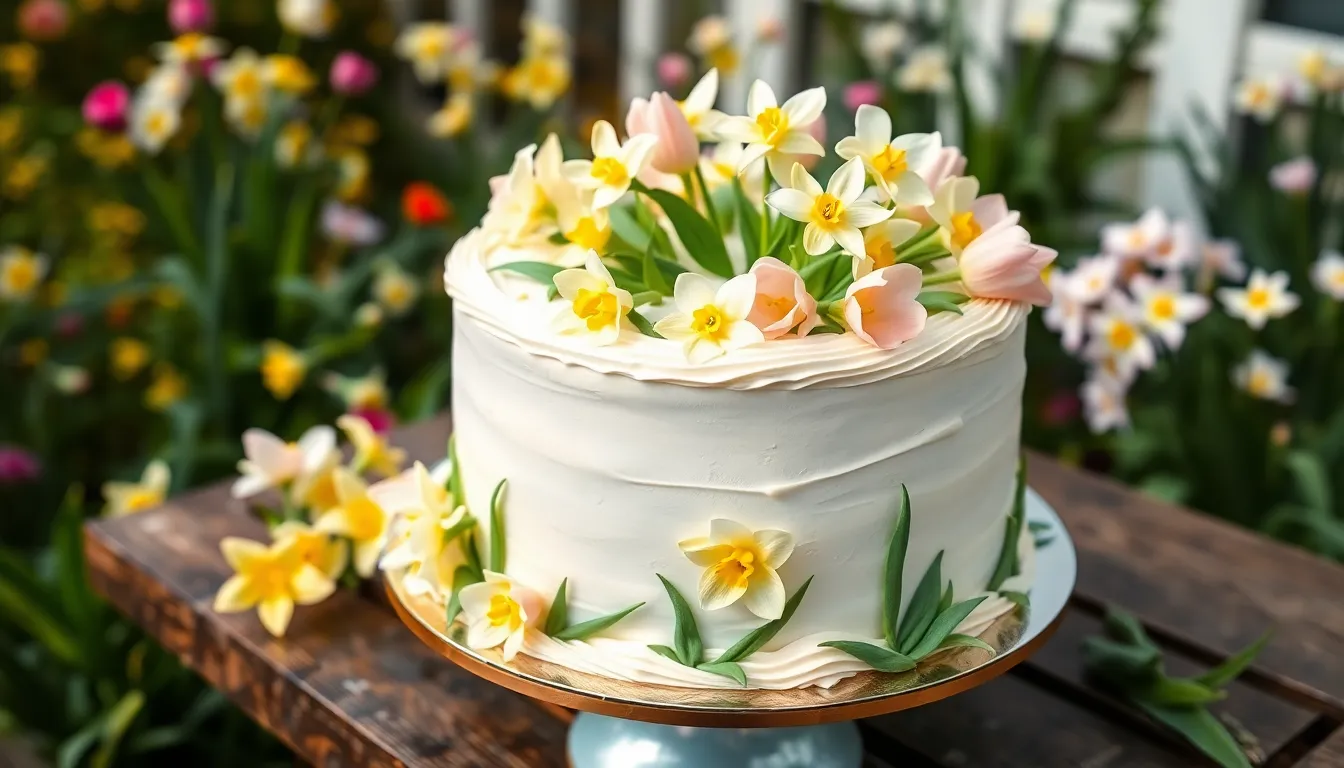
Garden cake themes transform beautifully throughout the seasons, allowing us to capture nature’s changing beauty in edible form. Each season brings its own palette of colors, textures, and natural elements that we can recreate through skilled cake artistry.
Spring Tulip and Daffodil Cakes
Spring garden cakes celebrate the awakening of nature with delicate tulip and daffodil designs. We create these stunning flowers using buttercream piping techniques, arranging them in wreaths or scattered bouquets across the cake surface. Soft pastels dominate our color palette, with gentle pinks, sunny yellows, and fresh greens that capture the season’s uplifting spirit.
Our approach involves crafting fondant tulips with slightly curved petals to mimic their natural shape. Daffodils require special attention to their distinctive trumpet centers, which we form using small pieces of yellow fondant. Leafy buttercream greenery provides the perfect accent, creating natural-looking stems and foliage that ground these blooms in realistic garden settings.
These spring designs work perfectly for garden parties, Easter celebrations, or birthday gatherings during the blooming season. Romantic touches like pearl dust or edible glitter enhance the delicate appearance of these seasonal masterpieces.
Summer Sunflower Garden Designs
Summer brings vibrant energy that we capture through bold sunflower garden cake designs. These cakes showcase the season’s warmth with bright yellow petals and rich brown centers that immediately evoke sunny days. We often design rectangular cakes to resemble thriving vegetable patches, complete with chocolate “soil” and realistic fondant vegetables.
Sunflower motifs serve as stunning centerpieces on tiered designs. Our technique involves piping individual petals using star tips to create texture, then adding detailed brown centers with small buttercream dots. Green buttercream leaves complete the realistic appearance of these cheerful blooms.
Vegetable garden elements enhance the summer theme perfectly. We create fondant tomatoes, peppers, and corn to create comprehensive garden scenes. Chocolate crumb “soil” provides an earthy foundation, while piped grass borders define different garden sections.
These designs excel at summer barbecues, gardener appreciation events, or outdoor wedding celebrations. Adding miniature garden tools or small plant markers creates authentic touches that delight guests.
Autumn Harvest Garden Themes
Autumn harvest cakes celebrate the season’s abundance with rich, earthy colors and bountiful vegetable displays. We focus on warm oranges, deep browns, and forest greens that reflect the changing industry. Pumpkins, gourds, and root vegetables take center stage in these seasonal designs.
Our technique involves creating realistic fondant vegetables like carrots with their leafy tops, round radishes, and various squash shapes. We arrange these elements on chocolate soil or textured buttercream to simulate freshly harvested garden beds. Detailed painting with food coloring adds authentic color variations to each vegetable.
Peter Rabbit inspired designs bring storybook charm to autumn cakes. We create neat rows of different vegetables, each section clearly defined with small fondant markers. Garden fence details made from modeling chocolate add whimsical touches that transport viewers into beloved children’s tales.
Finishing touches include miniature garden gnomes, small wheelbarrows filled with harvest vegetables, or scattered autumn leaves made from colored chocolate. These elements create comprehensive harvest scenes that capture the season’s generous spirit perfectly.
Tiered Garden Landscape Cake Constructions
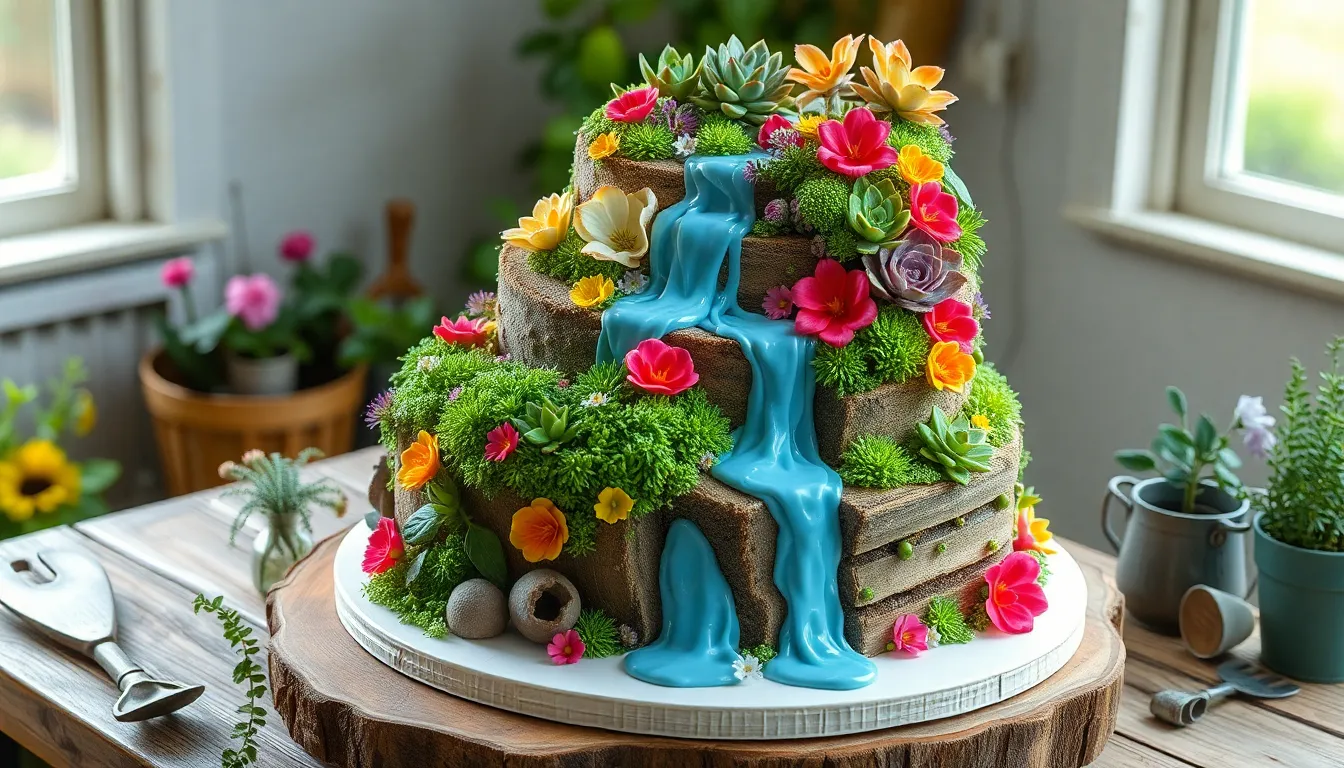
Building on our seasonal garden themes, we’ll now explore how multiple cake layers can create stunning three-dimensional garden landscapes. These architectural cake designs transform simple tiers into elaborate garden scenes that captivate guests at any celebration.
Multi-Level Garden Bed Designs
Creating multi-level garden bed designs requires layering different cake tiers to represent raised planters and garden boxes. We use buttercream or fondant succulents in varied green, blue, and purple hues arranged on top of each layer to simulate realistic succulent beds. Textured fondant sides resembling concrete planters enhance the authentic garden bed appearance.
Decorating each tier with edible flowers, carrots, and leafy greens mimics vibrant vegetable or flower beds found in actual gardens. We position these elements strategically to give depth and dimension to the overall design. Different textures and colors on each tier help distinguish separate garden levels while maintaining visual cohesion.
Varying the height and diameter of each layer creates the illusion of multiple raised garden beds at different elevations. We often incorporate realistic soil effects using crushed chocolate cookies or cocoa powder between decorative elements. Small edible garden tools and miniature plant markers add charming details that complete the garden bed theme.
Cascading Waterfall Garden Features
Incorporating cascading waterfall elements into tiered garden cakes requires creative piping techniques and strategic color placement. We use blue icing or gel to simulate water flowing down the sides of cake tiers, creating realistic water movement effects. Decorative piping with star tips helps achieve the flowing water texture that resembles natural waterfalls.
Sugar art techniques allow us to create three-dimensional water features that appear to cascade from one tier to another. We pair these flowing water effects with edible garden elements like fondant rocks, greenery, and delicate flowers to create complete waterfall scenes. Positioning these elements requires careful planning to ensure the water flow appears natural and visually appealing.
Watering can cupcakes serve as playful waterfall alternatives, featuring blue icing “water droplets” pouring from decorative spouts. We arrange these cupcakes around the main tiered cake to extend the water garden theme throughout the dessert display. Silver dragées or clear sugar crystals add sparkle that mimics sunlight reflecting off flowing water.
Terraced Garden Cake Structures
Designing terraced garden cake structures involves arranging multiple tiers in staggered or stepped configurations reminiscent of hillside gardens. We position each layer to step back or forward from the tier below, creating architectural interest that resembles natural garden terraces. This stepped arrangement provides multiple surfaces for elaborate garden decorations.
Floral and botanical decorations cascade down each tier to emphasize the terraced effect and enhance visual flow between levels. We use different flower varieties and foliage types on each terrace to represent diverse garden plantings. Buttercream roses, fondant peonies, and sugar paste leaves create lush garden landscapes across the terraced surfaces.
Varying the decoration density on each terrace helps guide the eye naturally from top to bottom while maintaining visual balance. We often incorporate small pathways made from crushed cookies or colored sugar that wind between terraced levels. These scenic, architectural cake designs provide dramatic focal points for garden parties, weddings, and outdoor celebrations.
DIY Garden Cake Decorating Techniques and Tips
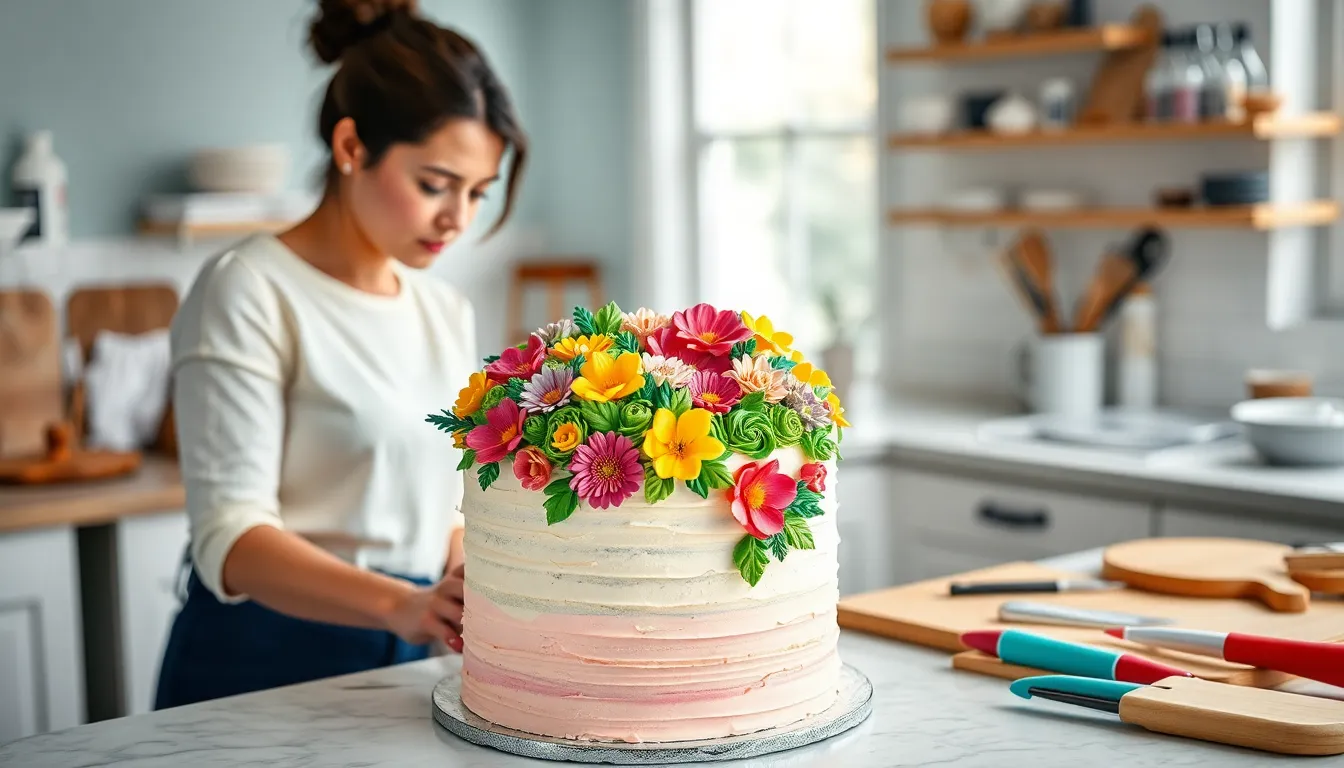
Creating spectacular garden cakes requires the right techniques and preparation to transform your vision into edible artistry. Let’s explore the essential elements that’ll help you master these beautiful designs.
Essential Tools for Garden Cake Creation
Piping bags and tips form the foundation of our garden cake toolkit. Round nozzles work perfectly for piping stems and creating delicate flower centers, while star tips add texture to grass and foliage. Leaf tips bring realistic dimension to garden greenery, allowing us to create varied leaf shapes and sizes.
Palette knives smooth buttercream surfaces and create natural texture effects. We use these tools to blend colors seamlessly and achieve that perfect watercolor sky effect on summer garden cakes. Offset palette knives work particularly well for reaching into tight spaces between decorative elements.
Turntables ensure even decorating from every angle. Rotating our cakes while working prevents uneven application and helps maintain consistent flower placement throughout the design. Professional decorators rely on sturdy turntables for complex garden industry creations.
Royal icing supplies create intricate small flowers and delicate greenery details. We need squeeze bottles for precise application and small brushes for adding fine touches to petals and leaves.
Color Mixing for Natural Garden Hues
Gel food coloring provides vibrant colors without thinning our buttercream or fondant. We divide our meringue buttercream into separate bowls before adding colors, ensuring each shade maintains its intensity. Swiss meringue buttercream holds color particularly well for watercolor effects.
Green variations require careful mixing to achieve natural garden tones. Forest green combines beautifully with tiny amounts of yellow for spring leaves, while sage green works perfectly for herb garden designs. We create multiple green shades to add depth and realism to our garden scenes.
Earth tones bring authenticity to our vegetable garden cakes. Brown and black food coloring combine to create realistic soil colors, while adding cocoa powder enhances the chocolate soil texture. We mix these colors gradually to achieve the perfect dirt appearance.
Pastel flower shades capture the delicate beauty of garden blooms. Pink gel coloring creates stunning roses when mixed with white buttercream, while purple and yellow combinations produce realistic pansy colors. We use pearls and sugar crystals to add shimmer and texture to our floral creations.
Assembly and Transport Considerations
Cake boards provide essential stability for our garden masterpieces. We mount each tier securely to prevent shifting during transport, using boards that extend slightly beyond the cake edges for easy handling. Multiple cake boards support complex tiered garden landscapes effectively.
Chilling requirements ensure our decorative elements stay intact. We chill completed cakes overnight before adding final details, allowing buttercream to set properly. This step prevents delicate piping work from losing its shape during assembly.
Transport boxes protect our creations during delivery. We select boxes with adequate height clearance for dimensional decorations like fondant vegetables and sugar flowers. Proper box sizing prevents damage to trailing greenery and fence details on vegetable garden cakes.
Assembly timing affects the final presentation quality. We add fresh edible flowers and delicate sugar work just before serving to maintain their appearance. Last minute touches like dusting with pearl dust or adding final greenery details preserve the magical garden effect.
Conclusion
Your garden cake dreams are now within reach with these creative ideas and techniques we’ve shared. From delicate buttercream flowers to whimsical fairy gardens these designs will transform any outdoor celebration into something truly magical.
Remember that practice makes perfect when it comes to garden cake decorating. Start with simpler designs and gradually work your way up to more complex creations as your skills develop.
Whether you’re planning a spring garden party or autumn harvest celebration there’s a perfect garden cake theme waiting for you. These edible masterpieces won’t just satisfy your guests’ sweet tooth – they’ll create lasting memories that capture the natural beauty of your special day.
Frequently Asked Questions
What are garden-themed cakes and why are they popular for outdoor celebrations?
Garden-themed cakes are edible artworks that feature nature-inspired designs like buttercream flowers, fondant vegetables, and botanical elements. They’re popular for outdoor celebrations because they complement natural settings, create stunning visual centerpieces, and offer a creative way to incorporate the beauty of gardens into special occasions like weddings, birthdays, and seasonal parties.
What are the main types of garden cake designs I can create?
The main types include floral fantasy cakes with buttercream or fondant flowers, vegetable garden themes featuring carrot patches and herb landscapes, butterfly and bee garden designs, whimsical fairy garden cakes, seasonal themes like spring tulips or autumn harvests, and tiered landscape constructions that create multi-dimensional garden scenes.
What essential tools do I need for decorating garden-themed cakes?
Key tools include various piping bags and tips for creating realistic flowers, palette knives for smooth surfaces, turntables for even decorating, fondant tools for detailed work, food coloring for natural garden hues, and wire armatures for three-dimensional elements like butterfly wings. Quality tools make a significant difference in achieving professional results.
How do I create realistic buttercream flowers for my garden cake?
Use specialized piping tips like petal tips for roses and star tips for sunflowers. Start with the center and work outward, applying consistent pressure. Create color gradients by adding darker shades to the piping bag’s sides. Practice on parchment paper first, then transfer finished flowers to your cake using a small spatula.
Can I use real flowers on my garden-themed cake?
Yes, but only use edible flowers like violas, pansies, nasturtiums, and lavender. Ensure they’re pesticide-free and food-safe. Clean them gently, remove stems, and place them just before serving to maintain freshness. Always research flower safety and consider guests with allergies before adding fresh flowers to cakes.
What techniques work best for fondant vegetable decorations?
Start with properly colored fondant, use realistic proportions, and add texture details with tools or household items. For carrots, create tapered shapes with green fondant tops. For radishes, use white fondant with pink tips. Build vegetables in stages, allowing each component to dry before assembly for best results.
How do I create tiered garden landscape cakes safely?
Use proper structural support with dowels or cake boards between layers. Chill each tier before stacking to maintain stability. Plan your design from bottom to top, considering weight distribution. Transport tiers separately when possible and assemble at the venue. Always prioritize structural integrity over complex designs for safety.
What are the best color combinations for natural garden themes?
Use earth tones like browns and greens for soil and foliage, soft pastels for spring themes, vibrant yellows and oranges for summer designs, and rich burgundy and gold for autumn cakes. Mix colors gradually to achieve natural gradients. Avoid overly bright artificial colors that don’t occur naturally in gardens.
How far in advance can I make garden cake decorations?
Fondant decorations can be made 1-2 weeks ahead and stored in airtight containers. Buttercream flowers can be made 2-3 days in advance and refrigerated. Fresh flower decorations should be added day-of or just before serving. Plan your timeline to balance advance preparation with maintaining freshness and visual appeal.
What are some beginner-friendly garden cake designs to start with?
Begin with simple buttercream grass borders, basic fondant mushrooms, or naked cakes decorated with fresh herbs. Try single-tier designs with piped flowers or vegetable garden patches. Master basic techniques like smooth buttercream and simple piping before advancing to complex multi-tiered landscapes or intricate fondant work.







